2015-08-27
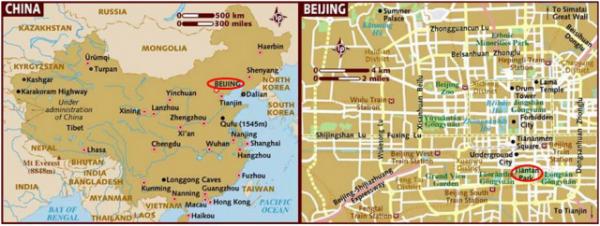
【Aiden in English】
The sky has been integral to Chinese history since the inception of its culture. I mean, which culture doesn't worship the never-ending blue, whatever-cha-ma-call-it, above its head? The Chinese emperors constructed an enormous complex known as the Temple of Heaven, where they could communicate with the sky, worship it, and observe it. Nowadays, there isn't much sky to watch in Beijing, except for pollution and smog, but that's not the point. Three principal buildings comprise the Temple of Heaven, yet not all their purposes for worship are fulfilled. The Hall of Prayer for Good Harvests was the emperor's place of worship. With a unique decoration of the phoenix pattern, this triple-gabled round hall built for the sky caught my eye immediately. Of all the Chinese parks or memorial places I've been to, none of them were constructed circularly. The roof was also blue, something I didn't often see. A level of status was indicated by the color of the roof. Blue was the top tier with the gods, and yellow was for the emperor beneath them. It was a pleasant surprise to have a culture where the ruler admitted he was not a god or its equivalent. There are 28 pillars in the Hall of Prayer for Good Harvests, i.e., four central dragon-well pillars for four seasons, 12 golden pillars in the middle for 12 months of a year, 12 peripheral pillars for the 12 early branches of a day, 24 outer pillars for 24 solar terms, 28 internal pillars for the 28 mansions, 36 backbones of 28 internal pillars and eight upper bronze columns for the 36 Heavenly Spirits. The ancient Chinese were stunning architects. One of their most monumental accomplishments was the Echo Wall. The Imperial Vault of Heaven looked circular, but it wasn't a perfect circle. Because of its irregular shape, the sound waves could run around the outer wall and be heard on the opposite side of the circular structure, much like a voice from heaven. For such an ancient civilization, mastering the art of sound was incredible. Today, the outer wall was blocked off because idiots kept carving their names onto the stone. The architecture was exact, but now, the small markings threw the sound off, ruining the magic. The Circular Mound Altar is probably the most famous of the three main buildings. This was where the emperor would chat with the sky, although I'm sure it was not a conversation when only one person was talking. Like the other temple, this platform had three flights of nine steps. No. 9 is the most significant number in Chinese culture, associated with the emperor. Having a number dedicated to you sounds unusual, and it's yours to use exclusively. Then, the platform itself was built around the concept of the number nine. The inner ring of tiles contained nine tiles, the next had 18, the third had 27, and so on. It reached a high of 81. And in the center of this mathematical altar was a single, protruding marble known as the Heart of Heaven. It was the very stone that an emperor stood on to talk about. It made him closer to the sky. Yeah, just by like two centimeters. The sky is one common worshipping theme in all cultures. It can bring rain and sun for nature, heatwaves and acrid cold for us, or droughts and floods for crops. It’s all up to the sky to choose, and it’s wise to try and persuade it to aid, not destroy. 【红霞译】
盘古开天以来,上苍在中国历史上占据着重要地位,说实在的,没有一个文化不祈祷脑袋瓜上顶的那片无边无际蔚蓝色随你怎么称呼的天空。
于是,中国皇帝便下令修建巨大无比的天坛来祈福民生,在那里他们能与老天爷聊天,可以祭祀昊天上帝,甚至静观天象。如今,北京上空不是污染就是雾霾,难得一见晴朗天空,但这些不是我要谈的话题。天坛里有三座主要建筑物,并非全部都用来祈谷祭天。
祈年殿是皇帝亲临祈祷的地方,这个专为敬天礼神而设并特别配以金凤和玺彩画装饰的三重屋檐圆形建筑立刻吸引了我的注意力。在本人见过的所有中国祭祀场所从未看到任何像眼前这样圆形结构。祈年殿顶端被涂成罕见的蓝色,显然,只有特殊建筑房顶才会使用这种颜色,蓝色暗指上苍,黄色明指皇帝。令人惊喜地发现,在依靠奉天行事的文化国度里,以真龙天子自居的统治者公然承认蓝色至高无上,是天神的化身,而自己不是天神,顶多算作天神的臣民。祈年殿共有廿八根柱子,四根中央龙井柱象征着春夏秋冬四个季节,十二根中层金柱表示一年十二个月,十二根檐柱代表一天十二个时辰,廿四根外柱意指每年廿四节气,廿八根内柱衬托天上廿八星宿,由廿八根内柱和八根铜柱组合而成的卅六根顶梁柱体现卅六天罡。
古代中华建筑师一直享有盛名,最具造诣的杰出作品之一就是回音壁。皇穹宇呈圆形,其弧度毕竟不像圆那样规范。正因如此,声波能够沿着墙壁折射向前,将耳朵贴在墙壁外面可以清楚地听到身处另外一端人发话,着实体味“天人感应”。对于古代文明,先辈们如此精通高深技术令人惊叹不已。如今回音壁的传声功能已大大消退,原因出自有些无法无天的人在石墙上刻字,从而破坏了墙壁表面的平滑性,使得神奇效果荡然无存。
在三座主要大殿中名声最响的是圜丘坛,这是皇帝与老天爷套近乎的地方,当然我敢保证所谓拉呱莫过于一个人自言自语。正如其它祭殿,圜丘坛共分三层,每一层有九级台阶,因为九是中国文字中最大的阳数,所以也成了皇帝专用数字,世上竟有一数字为你而设,而且被你化为己有,听起来该有多别扭。祭坛严格贯彻“九”(久)字精神。内圈有九块瓷砖,第二圈有十八块瓷砖,第三圈有廿七块瓷砖级,最后一圈共有八十一块瓷砖。在计算精密的同心圆中心镶嵌着天心石,那可是“上天垂象,亿兆景从”一呼百应的大理石,皇帝站在上面顿觉与老天爷拉近了距离,哪怕仅有两厘米之别。 世上所有民族文化都格外崇拜穹苍,它让大自然充满雨露阳光,给人类带来酷暑严寒,让农作物耐受旱亢沥涝,说来真是想干什么就干什么。因此明智的做法就是,要好好利用它为我们造福,而不要违背天理与它对立。
Today in History(历史上的今天): 2016 MontCo Youth Field Day(2016年蒙郡青少年野营日) 2014: GHCS Camp─Origami(光华夏令营折纸) 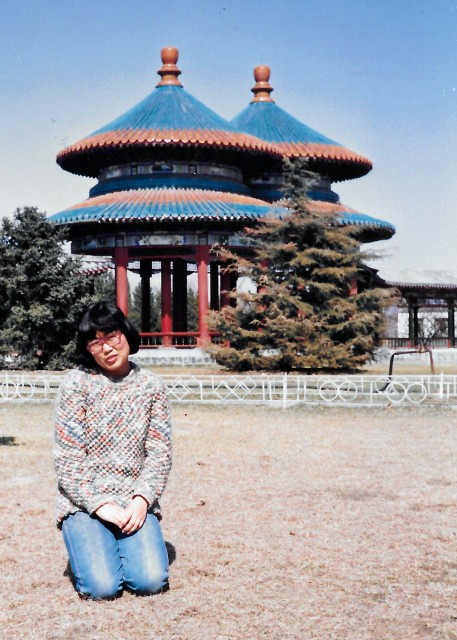
Double-Ring Longevity Pavilion (双环长寿亭 04-13-1986) 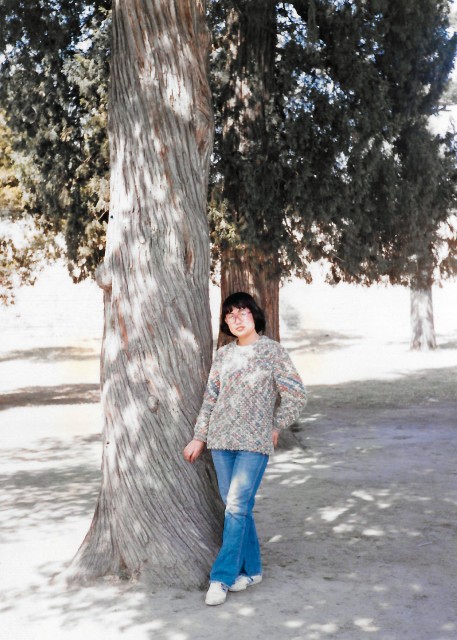
Ancient Pines (古柏 04-13-1986)
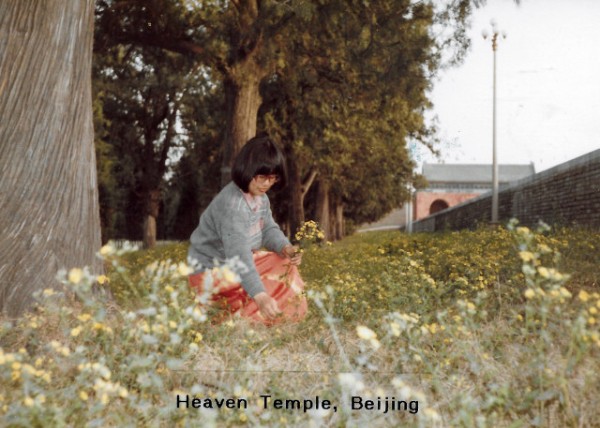
Ancient Pines (古柏 05-04-1987) 
Circular Mound Altar (圜丘坛) 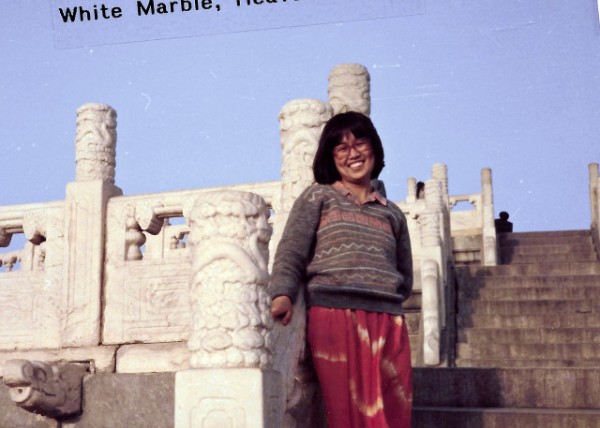
Circular Mound Altar (圜丘坛 05-04-1987) 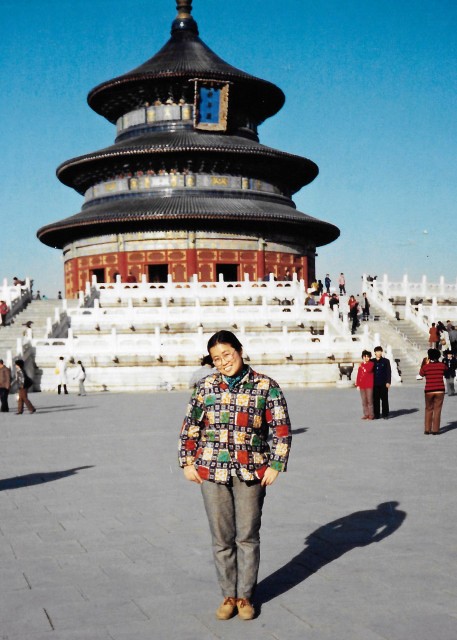
Hall of Prayer (祈年殿 11-24-1988) 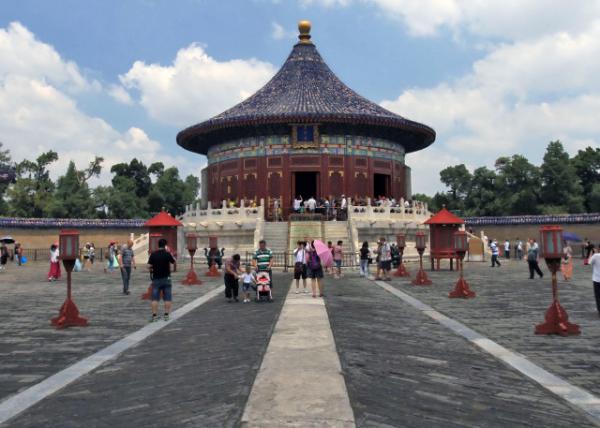
Imperial Vault of Heaven (皇穹宇)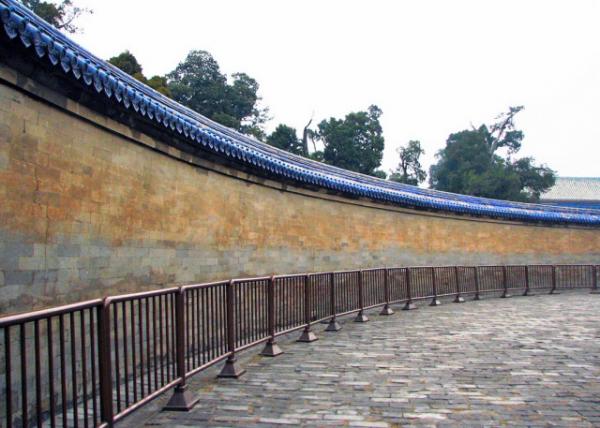
Echo Wall (回音壁) 
Echo Wall (回音壁 11-24-1988) Crosslinks(相关博文): China(出游中国) 6th Grade(初中一年级) |
